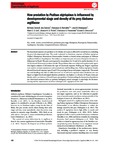Please use this identifier to cite or link to this item:
http://www.alice.cnptia.embrapa.br/alice/handle/doc/1066089Full metadata record
| DC Field | Value | Language |
|---|---|---|
| dc.contributor.author | SANTOS, B. D. B. dos | pt_BR |
| dc.contributor.author | RAMALHO, F. de S. | pt_BR |
| dc.contributor.author | MALAQUIAS, J. B. | pt_BR |
| dc.contributor.author | LIRA, A. C. S. | pt_BR |
| dc.contributor.author | PACHÚ, J. K. S. | pt_BR |
| dc.contributor.author | FERNANDES, F. S. | pt_BR |
| dc.contributor.author | ZANUNCIO, J. C. | pt_BR |
| dc.date.accessioned | 2017-03-03T11:11:11Z | pt_BR |
| dc.date.available | 2017-03-03T11:11:11Z | pt_BR |
| dc.date.created | 2017-03-03 | pt_BR |
| dc.date.issued | 2016 | pt_BR |
| dc.identifier.citation | Entomologia Experimentalis et Applicata, n. 158, p. 142-151, 2016. | pt_BR |
| dc.identifier.uri | http://www.alice.cnptia.embrapa.br/alice/handle/doc/1066089 | pt_BR |
| dc.description | The functional response of a predator to the density of its prey is affected by several factors, including the prey?s developmental stage. This study evaluated the functional response of Podisus nigrispinus (Dallas) (Hemiptera: Heteroptera: Pentatomidae) females to fourth instars and pupae of Alabama argillacea (H?ubner) (Lepidoptera: Noctuidae), an important pest of cotton (Gossypium hirsutum L., Malvaceae) in Brazil. The prey were exposed to the predator for 12 and 24 h, and in densities of 1, 6, 12, 18, 24, and 30 items per predator female. The predation data were subjected to polynomial regression logistic analysis to determine the type of functional response. Holling and Rogers? equations were used to estimate parameters such as attack rate and handling time. Podisus nigrispinus females showed functional response types II and III by preying on larvae and pupae, respectively. The attack rate and handling time did not differ between the 12 and 24 h exposure times. Predation rate was higher at higher larval and pupal densities; predation was highest at a density of 30 prey items per female, and it was similar at 18 and 24 prey per predator. Understanding the interaction of predators and their food resources helps to optimize biological control strategies. It also helps the decisionmaking and the improvement of release techniques of P. nigrispinus in the field. | pt_BR |
| dc.language.iso | eng | eng |
| dc.rights | openAccess | eng |
| dc.title | How predation by Podisus nigrispinus is influenced by developmental stage and density of its prey Alabama argillacea. | pt_BR |
| dc.type | Artigo de periódico | pt_BR |
| dc.date.updated | 2017-03-06T11:11:11Z | pt_BR |
| dc.subject.thesagro | Gossypium hirsutum | pt_BR |
| dc.subject.thesagro | Algodão | pt_BR |
| dc.subject.thesagro | Hemiptera | pt_BR |
| dc.subject.nalthesaurus | Cotton | pt_BR |
| riaa.ainfo.id | 1066089 | pt_BR |
| riaa.ainfo.lastupdate | 2017-03-06 | pt_BR |
| dc.contributor.institution | BÁRBARA DAVIS B. dos SANTOS, CNPA; FRANCISCO DE SOUSA RAMALHO, CNPA; JOSE BRUNO MALAQUIAS, CNPA; ALINE C. S. LIRA, CNPA; JÉSSICA K. S. PACHÚ, CNPA; FRANCISCO S. FERNANDES, CNPA; JOSÉ C. ZANUNCIO, UFV. | pt_BR |
| Appears in Collections: | Artigo em periódico indexado (CNPA)  | |
Files in This Item:
| File | Description | Size | Format | |
|---|---|---|---|---|
| HowpredationbyPodisusnigrispinus.pdf | 357.17 kB | Adobe PDF |  View/Open |









